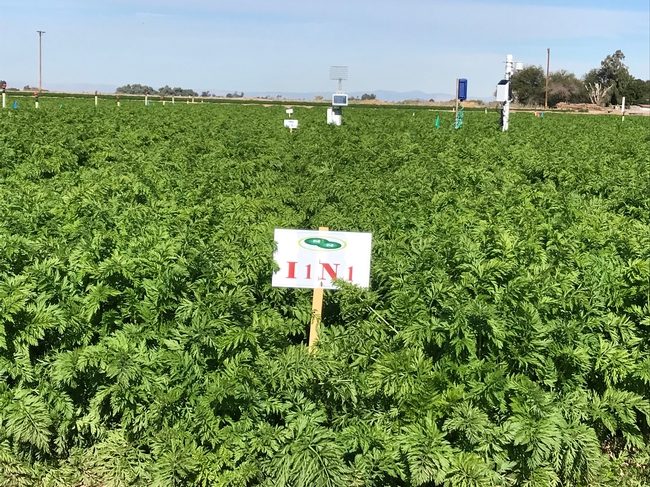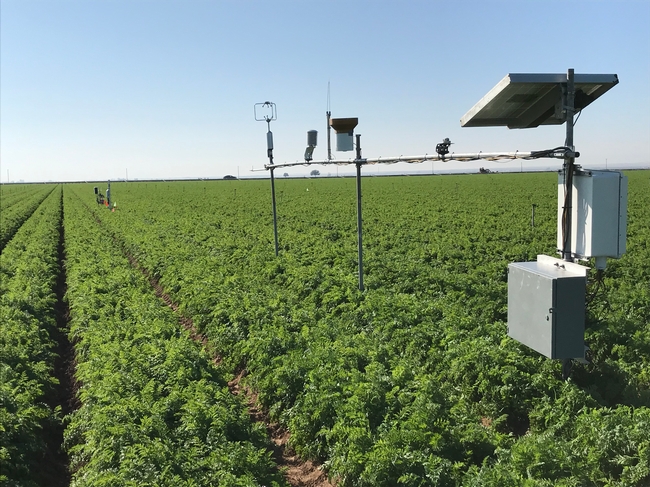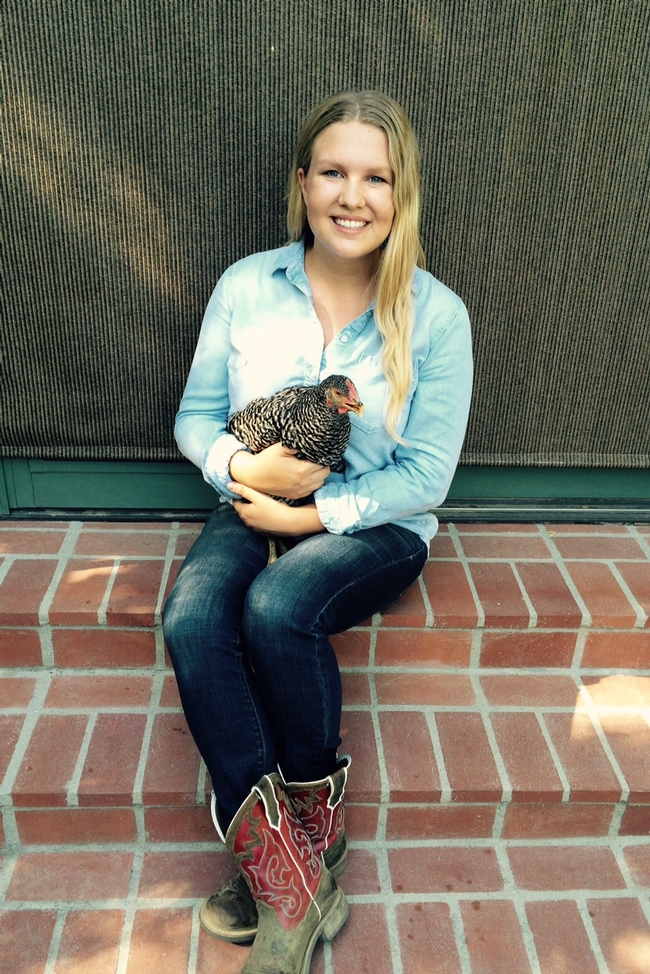
Posts Tagged: Kern
New research fills gap on best practices for California carrot production
One doesn't need to be a seasoned farmer to know that growing conditions in Canada are completely different than those found in the low desert of California.
And yet, for many years, studies conducted in Canada were used to generate nitrogen uptake data for the California carrot production system, so growers managed their fields based on their own experiences – and that research conducted thousands of miles to the north.
Carrots had been among the crops grown in California that did not have site-specific data to suggest the best source, rate, timing and placement of nitrogen, in the highly variable cropping seasons and locations throughout the state. That's why new information – based on local research and published in August – is invaluable to farmers in Imperial and Kern counties, where the majority of the carrots in California are grown.
Two years of data from two experimental trials at UC Agriculture and Natural Resource's Desert Research and Extension Center – as well as from 10 commercial fields – produced key recommendations for farmers to make the most of their irrigation and nitrogen applications.
“The point is we developed information in your field, based on your practices, your climate, your production system – and this is what is really happening,” said Ali Montazar, UC Cooperative Extension irrigation and water management advisor for Imperial County. Montazar conducted the study alongside Daniel Geisseler, UCCE nutrient management specialist at UC Davis, and Michael Cahn, UCCE irrigation and water resources advisor for Monterey County.
With reliable data gathered under real-world conditions, Montazar said growers now have solid reference points for when – and at what rate – to irrigate and apply fertilizers in the low desert environment. One of the key findings, for example, was that the carrots' nitrogen uptake is generally low in the first 40 to 50 days, so growers are advised to limit their fertilizer application during that period.
Then, by tailoring those basic guidelines to their own site-specific situation and optimizing their practices, growers can maximize the amount of nitrogen taken up by the carrots – and minimize the amount that is leached out.
“Improving irrigation and nutrient management in the desert production system is what local growers are themselves trying to achieve. With improving efficiency and reducing nutrient leaching, we can improve the quality of water in the Salton Sea,” said Montazar, noting the longstanding challenges of reducing contaminants from irrigated lands to protect its unique ecosystem and wildlife.
While contamination of groundwater is not a critical issue in the desert, the best practices in this study can also help carrot growers in parts of California where nitrogen leaching into groundwater and drinking water supplies is a greater concern.
Montazar is currently leading a team in studying carrot-growing management practices under slightly different conditions in Kern County, with the hopes of publishing findings in late summer 2022.
The Imperial County study, “Spatial Variability of Nitrogen Uptake and Net Removal and Actual Evapotranspiration in the California Desert Carrot Production System,” is published in the journal Agriculture, and can be found at https://doi.org/10.3390/agriculture11080752. Findings and recommendations also appear in Progressive Crop Consultant: https://progressivecrop.com/2021/09/new-knowledge-based-information-developed-to-enhance-water-and-nitrogen-use-efficiency-in-desert-fresh-market-carrots/.
Funding for this study was provided by the California Department of Food and Agriculture's Fertilizer Research and Education Program, as well as the California Fresh Carrots Advisory Board.
Salty fries? Yum. Salty Water and Soil? Not So Much.
Can compost help me with my salt problems? Increasing soil salinity poses an existential...
Climate Smart Agriculture: What is it and who can help me implement it?
What exactly is climate smart agriculture? The Food and Agriculture Organization of the...
STEM Grows in 4-H!
We are launching our monthly STEM Highlights with two stories about 4-H'ers doing STEM...
UCCE intern reflects on her summer experiences

Maybe it's the elusive feeling of belonging to something bigger than yourself, of being a part of the community whose work is rarely seen up close and even less frequently understood by the majority of society. It's a feeling of being connected to the past - part of an ageless industry, something essential and concrete.
It was this feeling that began the summer in which I learned more about agriculture than any book has yet to teach me, became even more enamored with the industry that is the heartbeat of our valley, and became involved with the community that works endlessly to keep that heartbeat steady and strong.
I was fortunate enough to be chosen for the University of California Cooperative Extension of Kern County's DiGiorgio Internship, a summer position that gives one student studying agriculture at the college level the opportunity to work with all of the farm advisors, thereby getting broad-based and hands-on work experience.
From cattle auctions and range evaluations to variety trials and almond harvests, I worked alongside the dedicated UCCE staff, helping with projects and experiments, attending lectures, going along on farm calls, and everything in between. Working with all of the advisors gave me a very realistic sense of the full cycle of farming and everything involved, from pest management and soil health to irrigation techniques and all of the extensive equipment and technology.
This summer was packed full of new experiences for me. As someone who does not come from an agricultural background, every day was a new adventure. I saw more varieties of potatoes than I knew existed at potato field day. I helped plant a field of pumpkins and then climbed onto a tractor for the first time a few weeks later, unsteady at first but soon confidently cultivating the rows, proud of a morning's work. I harvested tomatoes and admired the bright red fruit produced in the California sunshine.

I learned about the spirit of generosity that is so prevalent in the agricultural community. I received countless words of advice and wisdom from farmers, ranchers, writers, and teachers and met people ranging from 80-year-old cattlemen to fresh-out-of-college farm advisors, all equally enthusiastic about preserving the traditions of our valley while improving the industry and way of life. I came home many days hot and tired, but satisfied and feeling like I did something truly worthwhile.
This internship showed me the significance of UC Cooperative Extension's work. Behind the scenes, the advisors are constantly solving problems and doing the research to prevent them before they happen. They work towards achieving the best results possible because they know that their results do not just affect one grower, crop or sale; eventually, they affect us all. The advisors' generosity in sharing their knowledge with me was invaluable, and it was an honor to work for an organization that is constantly improving our most important industry.
That first early morning in that vineyard, only one thought ran through my mind: it's going to be a long, hot summer. Now, I'm looking my last week of work in the eye, with a pair of worn out boots in my hand and a lot more knowledge in my head. I started the summer only knowing that I had a passion for agriculture. I'm still drawn to it for the same reasons: being a part of something tangible, essential, historical, grounded and evolving. But I'm ending it with a much more realistic and extensive view of the industry, excited about the endless possibilities and confident in the years ahead.

